Venus Probes
The Exploration of Venus
The first successful flyby of the Planet Venus was accomplished by Mariner 2 in 1962.
In 1970, the Soviet Venera 7 lander became the first probe to return data from the surface of Venus. Later Venera landers would return images from the surface.
America sent two spacecraft to the planet in 1978. The Pioneer Venus Orbiter went into orbit around the planet, while the Pioneer Venus Multi-Probe deployed four atmospheric entry probes to investigate the atmosphere.
The twin Vega spacecraft each deployed a surface lander and an instrumented atmospheric balloon in 1985.
The American Magellan mission, launched on the Space Shuttle in 1989, used a radar system to create high-resolution maps of the planets surface.
Launched in 2005, the European Venus Express mission continues to orbit the planet.
Mariner Venus Missions
The Mariner program consisted of ten exploration probes launched between 1962 and 1973. Mariners 2 and 5 each conducted a flyby of Venus, Mariner 10 conducted flybys of both Venus and Mercury. Other Mariner spacecraft explored Mars.

Mariner 2 Venus fly-by spacecraft.

Mariner 2 (Venus Flyby Probe)
Launched on 27 August 1962, Mariner 2 was the first spacecraft to visit Venus. The spacecraft was launched on an Atlas Agena-B rocket (right), from launch complex 12 at Cape Canaveral Air Force Station. Closest approach to Venus, 34,773 km, occurred on 14 December 1962.
Mariner 2 experiments included a microwave radiometer, an infrared radiometer, a magnetometer, a cosmic ray detector, a cosmic dust detector, a solar plasma spectrometer, a particle detector, and a celestial mechanics experiment.
The spacecraft's electronics were contained in a hexagonal base, measuring 1.04 m across and .36 m tall. A pyramid shaped structure, supporting some of the scientific instruments, was mounted on top of the hexagonal base. Two solar panels, .76 m wide and with a total span of 5.05 m, provided electrical power. A high gain directional dish antenna, mounted below the hexagonal base, was used for communications with Earth. A cylindrical omni-directional antenna was mounted on top of the pyramid structure. A monopropellant propulsion system was used for midcourse maneuvers.
A sister mission, Mariner 1, was destroyed in a launch vehicle failure on 22 July 1962. The Atlas-Agena rocket veered off course and had to be destroyed by the range safety officer.
Mariner 2 Replica
These photos are of a replica, constructed from test components, on display at the National Air and Space Museum. (Photos: Richard Kruse, 2009)
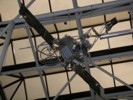
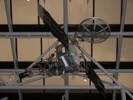
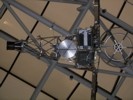
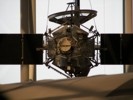

Mariner 5 (Venus Flyby Probe)
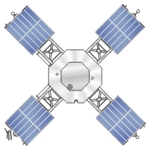
Mariner 5
Mariner 5 was launched on 14 June 1967, on an Atlas Agena-D rocket (right), from launch complex 12 at Cape Canaveral Air Force Station. Closest approach to Venus, around 4,000 km, occurred on 19 October 1967.
The spacecraft was built as a backup for the Mariner 4 Mars probe. After the success of Mariner 4, the Mariner 5 spacecraft was reconfigured for a Venus flyby.
Mariner 5 experiments included an interplanetary ion plasma probe, a trapped radiation detector, a triaxial low field helium magnetometer, an ultraviolet photometer, a two-frequency beacon receiver experiment, an S-band occultation experiment, and a celestial mechanics experiment.

Mariner 10 (Flybys of Venus and Mercury)
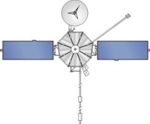
Mariner 10
Launched on 3 November 1973, Mariner 10 conducted flybys of both Venus and Mercury, becoming the first spacecraft to visit two planets. The spacecraft was launched on an Atlas Centaur rocket (right), from launch complex 36B at Cape Canaveral Air Force Station. The Venus flyby, with a closest approach of 5,768 km, occurred on 5 February 1974. A total of three Mercury flybys were conducted, occurring on 29 March 1974, 21 September 1974, and 16 March 1975.
Mariner 10 Flight Spare
These photos are of the Mariner 10 backup spacecraft, on display at the Udvar-Hazy Center. (Photos: Richard Kruse, 2009)

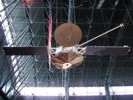
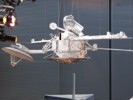
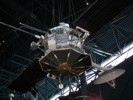
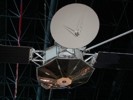
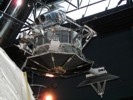
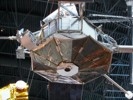
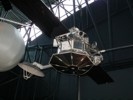
Venera Program
Venera was a series of Venus probes launched by the Soviet Union between 1961 and 1983. Many of the earlier missions failed to achieve their objectives. Later missions included many significant accomplishments, including the first spacecraft to penetrate another planets atmosphere (Venera 4), the first soft landing on another planet (Venera 7), the first photos taken from the surface of Venus (Venera 9), and the first color photos taken on the surface (Venera 13).

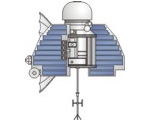
Venera 1
Venera 1
Venera 1 (left) was launched on 12 February 1961 on a Molniya rocket (right). Communications were lost with the spacecraft several days after launch.
Venera 2
Venera 2 was launched on 12 November 1965 on a Molniya rocket. On 27 February 1966, Venera 2 passed within 24,000 km of Venus. A communication failure prevented data from being returned.
Venera 3
Venera 3 was launched on 16 November 1965 on a Molniya rocket. Designed to land on the surface of Venus, Venera 3 was the first spacecraft to impact the planet. A communication failure prevented data from being returned.

Venera 4
Venera 4
Venera 4 (left) was launched on 12 June 1967 on a Molniya rocket. The Venera 4 descent probe was the first to return data from within Venus's atmosphere. The probe transmitted atmospheric data until it reached an altitude of 24.96 km.
Venera 5
Venera 5 was launched on 5 January 1969 on a Molniya rocket. On 16 May 1969, descent probe penetrated the atmosphere of Venus. The probe transmitted atmospheric data for 53 minutes.
Venera 6
Venera 6 was launched on 10 January 1969 on a Molniya rocket. On 17 May 1969, descent probe entered the atmosphere of Venus. During descent, atmospheric data was transmitted for 51 minutes.
Venera 7
Venera 7 was launched on 17 August 1970 on a Molniya rocket. The descent probe entered the atmosphere of Venus on 15 December1970. Surviving descent and landing, the spacecraft returned data for 23 minutes from the surface. Venera 7 was the first probe to return data after landing on the surface of another planet.
Venera 8
Venera 8 was launched on 27 March 1972 on a Molniya rocket. After separating from the bus, the descent vehicle penetrated the atmosphere of Venus on 22 July 1972. The probe survived landing and transmitted data from the surface for 50 minutes.
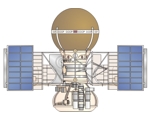
Venera 9

Venera 9
Venera 9 (left) was launched on 8 June 1975 on a Proton rocket (right). The spacecraft consisted of an orbiter and a descent vehicle. The descent vehicle reached the surface on 22 October 1975 and returned the first black and white images from the surface of Venus. Surface data was returned for 53 minutes after landing.
Venera 10
Venera 10 was launched on 14 June 1975 on a Proton rocket. The spacecraft consisted of an orbiter and a descent vehicle. The descent vehicle reached the surface on 25 October 1975 and returned black and white images of the nearby surface. The lander operated for 65 minutes on the surface.
Venera 11
Venera 11 was launched on 9 September 1978 on a Proton rocket. The spacecraft consisted of a bus and a descent vehicle. The descent vehicle landed on 25 December 1978 and operated for at least 95 minutes on the surface. A failure in the imaging system prevented surface images from being returned.
Venera 12
Venera 12 was launched on 14 September 1978 on a Proton rocket. The spacecraft consisted of a bus and a descent vehicle. The descent vehicle landed on 21 December 1978 and returned data for 110 minutes. A failure in the imaging system prevented surface images from being returned.
Venera 13
Venera 13 was launched on 30 October 1981 on a Proton rocket. Venera 13 included a bus and a descent vehicle. The descent vehicle, landing successfully on 1 March 1982, operated on the surface for 127 minutes and returned color photos.
Venera 14
Venera 14 was launched on 4 November 1981 on a Proton rocket. Venera 14 included a bus and a descent vehicle. The descent vehicle, landing successfully on 5 March 1982, operated on the surface for 57 minutes and returned color photos.

Venera 15
Venera 15
Venera 15 (left) was launched on 2 June 1983 on a Proton rocket. An orbital mission, Venera 15 used a radar system to map the surface of Venus.
Venera 16
Venera 16 was launched on 7 June 1983 on a Proton rocket. An orbital mission, Venera 16 used a radar system to map the surface of Venus.
Pioneer Venus
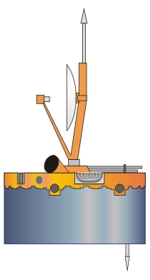
Pioneer Venus Orbiter

Pioneer Venus Orbiter
Pioneer Venus Orbiter was launched on an Atlas-Centaur rocket on May 20, 1978. The solar powered, spin stabilized spacecraft measured 2.5 m in diameter and was 1.2 m tall. The spacecraft contained a large number of scientific experiments. Among the 17 experiments was a surface radar mapper, a photopolarimeter, and several spectrometers.
The spacecraft entered orbit on December 4, 1978.
On October 8, 1992, after many years of operation and low on fuel, the spacecraft entered and burnt up in the atmosphere of Venus.
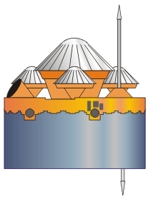
Pioneer Venus Multi-Probe

Pioneer Venus Multi-Probe
The Pioneer Venus Multi-Probe was launched on an Atlas-Centaur rocket (right) on August 8, 1978. The spacecraft consisted of a bus, a large atmospheric probe, and three smaller atmospheric probes. Approaching Venus in November, 1978, the atmospheric probes were released from the bus. The probes returned data about the composition and environmental conditions in the atmosphere of Venus. Although the probes were not designed to survive landing, one of the smaller probes continued to transmit data for over an hour after reaching the surface.
Bus
The Bus component of the Pioneer Venus Multi-probe mission carried the four atmospheric entry probes on the journey to Venus. The bus was a flat cylinder measuring 2.5 m in diameter and, by itself, weighed 290 kg. After releasing the atmospheric probes, the bus itself plunged into the atmosphere of Venus. Equipped with an ion mass spectrometer and a neutral mass spectrometer, the bus was able to return some data about the upper atmospheric layers before it was destroyed. Not equipped with a heat shield or parachute, contact was lost with the bus around 110 km altitude.
Large Atmospheric Entry Probe
The large atmospheric entry probe measured 1.5 m in diameter. The probe deployed a parachute to slow its descent through the atmosphere. Experiments included a neutral mass spectrometer, a gas chromatograph, a solar flux radiometer, an infrared radiometer, a cloud particle size spectrometer, a nephelometer, and a variety of sensors to record pressure, temperature, and acceleration forces. The large probe was targeted to an area near the equator on the night side of the planet. Analysis of radio transmissions during the descent provided additional information about winds and atmospheric conditions.
Small Atmospheric Entry Probes (3)
Each of the three small atmospheric entry probes measured .8 m in diameter. The probes consisted of an aeroshell surrounding a spherical pressure vessel. The small probes contained several scientific experiments, including a net flux radiometer experiment, a nephelometer, and sensors to record pressure, temperature, and acceleration forces. Each small probe was targeted toward a different part of the planet. The 'North probe' entered on the daylight side at 60 degrees north latitude. The 'night probe' landed on the night side around 29 degrees south latitude. The 'day probe' landed on the daylight side near 31 degrees south latitude. Although not equipped with parachutes, nor designed to land, the day probe survived landing and transmitted data from the surface for over an hour. As with the large probe, transmissions from each small probe were analyzed to help characterize atmospheric conditions encountered during descent.
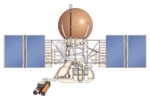
Vega Spacecraft

Vega
Two Vega probes were launched by the Soviet Union in 1984. Each probe deployed a lander and balloon at Venus, then performed a flyby of Comet Halley. Each mission was launched on a Proton rocket (right).
Instruments carried on the flyby spacecraft included a television system (TVS), a three-channel spectrometer (TKS), an infrared spectrometer (IKS), a dust mass spectrometer (PUMA), two dust particle Counters (SP-1) and (SP-2), a neutral gas mass spectrometer (ING), a plasma energy analyzer (PLASMAG), a energetic particle analyzer (TUNDE-M), a magnetometer (MISCHA), two Wave and plasma analyzers (APV-N) and (APV-V), a dust particle detector (DUCMA), and an energetic particle experiment.
Vega 1
Vega 1 was launched on 15 December 1984. Venus encounter and lander release occurred in June 1985. The encounter with Comet Halley occurred on 6 March 1986.
Vega 2
Vega 2 was launched on 20 December 1984. Venus encounter and lander release occurred in June 1985. The encounter with Comet Halley occurred on 9 March 1986.
Vega Spacecraft
Vega Spacecraft on display at the Udvar Hazy Center. (Photos: Richard Kruse, 2008)
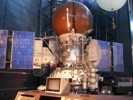
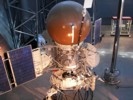

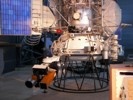
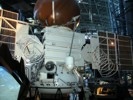
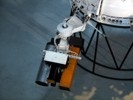
Venus Balloon and Instrument Package




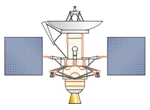
Magellan Venus probe
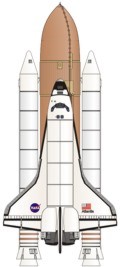
Magellan
The space shuttle Atlantis, carrying the Magellan spacecraft and an Inertial Upper Stage (IUS), lifted off from Kennedy Space Center on 4 May 1989.
Magellian arrived at Venus on 10 August 1990. A solid fuel rocket motor was used to place the spacecraft into orbit.
From its highly elliptical, polar orbit, Magellan used its cloud penetrating radar to map nearly the entire surface of Venus.
After several mapping cycles, the Magellan spacecraft was used to test aerobraking techniques. By dipping into the upper atmosphere, the spacecraft was able to lower its orbit.
Additional dips into Venus's upper atmosphere provided data about conditions there.
Its mapping mission, and subsequent aero-braking experiments, completed, Magellan was programmed to lower its orbit one last time on 11 October 1994. As planned, atmospheric drag slowed the spacecraft below orbital speed, causing it to re-enter and be destroyed. Last contact was made on 12 October 1994.
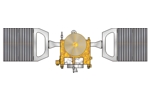
Venus Express orbiter.

Venus Express
Venus Express, a European Space Agency mission to Venus, was launched on 9 November 2005 on a Soyuz-Fregat rocket. Developed and launched in only three years, the spacecraft draws heavily on experienced gained with the Mars-Express spacecraft.
Venus Express carries a variety of scientific instruments, including the Venus Monitoring Camera (VMC), the Analyser of Space Plasma and Energetic Atoms (ASPERA), the Planetary Fourier Spectrometer (PFS), the Visible/Ultraviolet/Near-infrared Mapping Spectrometer (VIRTIS), the Venus Express Magnetometer (MAG), the Venus Radio Science Experiment (VeRa), and the Ultraviolet and Infrared Atmospheric Spectrometer (SPICAV/SOIR).
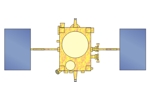
Venus Climate Orbiter

Venus Climate Orbiter (Akatsuki)
Mission
The Venus Climate Orbiter, sometimes known as "Akatsuki", or "Planet-C", is the first Venus probe developed by the Japan Aerospace Exploration Agency (JAXA). The scientific objectives of the mission are centered on the climate and atmosphere of Venus.
The mission was launched in May 2010, on a H-IIA launch vehicle.
The spacecraft neared Venus in December 2010. Unfortunately, an engine burn meant to place the vehicle into orbit was cut short. The spacecraft flew by Venus.
Venus Climate Orbiters current trajectory will again approach Venus in six years. Mission controllers are considering making another attempt to orbit Venus at that time.
Venus Climate Orbiter Instruments
The spacecraft is equipped with six scientific instruments to study the atmosphere of Venus.
1-Micron Camera (IR1)
2-Micron Camera (IR2)
Long wave Infrared Camera (LIR)
Ultraviolet Imager (UVI)
Lightning and Airglow Camera (LAC)
Ultra-stable Oscillator (USO)
 Images by Richard Kruse are licensed under a Creative Commons Attribution-Noncommercial 3.0 United States License.
Images by Richard Kruse are licensed under a Creative Commons Attribution-Noncommercial 3.0 United States License.


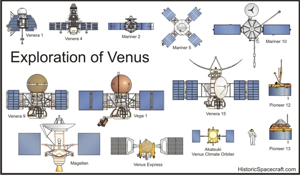







































 Images by Richard Kruse are licensed under a Creative Commons Attribution-Noncommercial 3.0 United States License.
Images by Richard Kruse are licensed under a Creative Commons Attribution-Noncommercial 3.0 United States License.